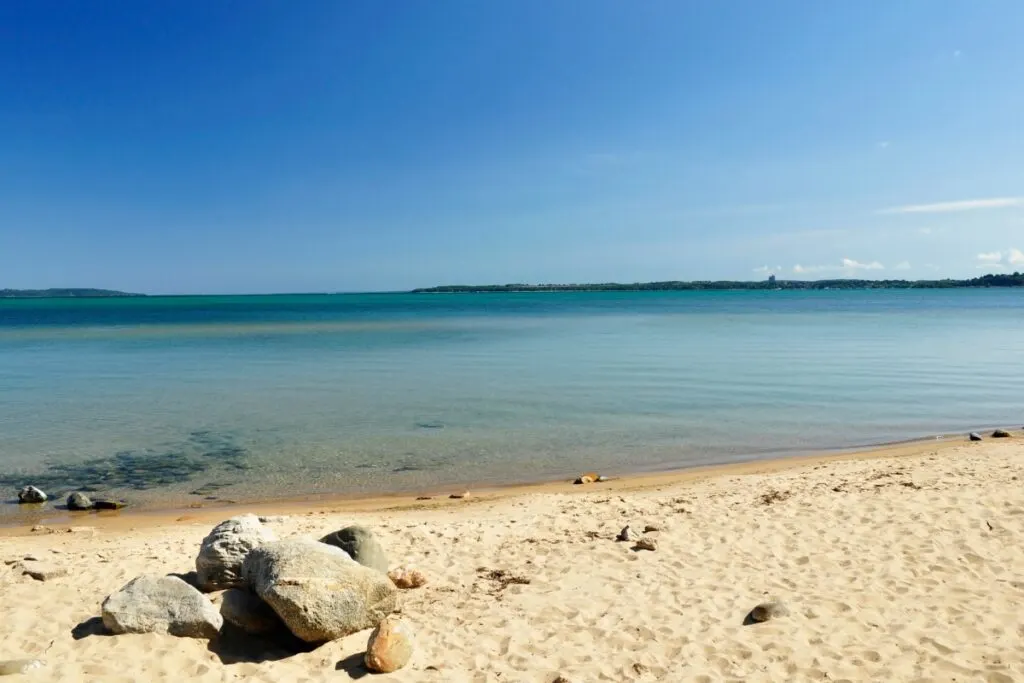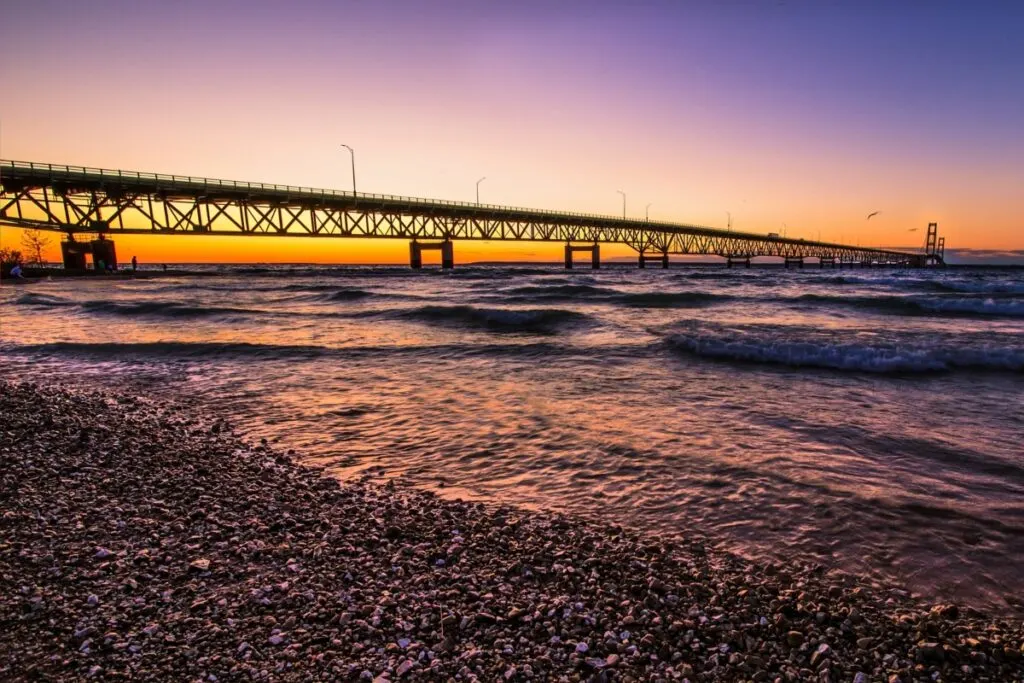As an Amazon Associate, I earn from qualifying purchases with no additional costs for you.
One of the best lakes in the world to rockhound is Lake Michigan. It is a giant lake bordered by four U.S. states, and the best part is that all of these states have numerous beaches where you can go and hunt for various rocks, crystals, and minerals.
Some of the best rock-hunting beaches on Lake Michigan include North Beach, Vans Beach, Petoskey State Park, Point Betsie Lighthouse Beach, Empire Beach, Barnes Park, Peterson Park, Racine North Beach, Port Washington South Beach Park, Rainbow Beach, North Avenue Beach, Grant Park Beach, or Oakwood Beach.
There are dozens and dozens of beaches and state parks surrounding Lake Michigan where you can find and, in some cases, collect beautiful rocks, such as the much coveted Petoskey stones, Lake Superior agates, pudding stones, and more!

If you want to check out the best rockhounding tools, you can find them by clicking here (Amazon link).
Is it Legal to Take Rocks from the Lake Michigan Shoreline?
Whether you are located in Michigan, Wisconsin, Illinois, or Indiana and want to take rocks from the Lake Michigan shoreline, you should always check the local regulations in your area.
For example, in most cases, you can’t collect rocks from the boundaries of national parks, national lakeshores, or historical sites designated for preservation.
In other instances, if you are on private land, you are also prohibited from collecting rocks unless you have permission from the landowners.
An annual limit is imposed on USDA-administered National Forests and National Recreation lands. In most cases, you can only take 10 lbs of specimens annually for personal use. When collecting rocks from state-owned or public trust lands, the usual annual limit is 25 lbs, at least for Michigan.
This limit is per person, and you can’t collect 25 lbs of the same rock material or go and collect 25 lbs of material from one location and then collect another 25 lbs from another site. Rules might differ in states like Wisconsin, Illinois, or Indiana.
However, the best way to stay informed is to contact the authorities that administer the beach or location you want to visit near Lake Michigan and see if you can collect. Sometimes, beach signs tell collectors about the rules they must follow.
BTW: Do you want to know more about rock and mineral identification? The books listed below are the best ones you can find on the internet (Amazon links):
- Smithsonian Handbooks: Rocks & Minerals
- Gemstone & Crystal Properties (Quick Study Home)
- Ultimate Explorer Field Guide: Rocks and Minerals (National Geographic Kids)
Best Rockhounding Beaches on Lake Michigan
No matter what state you are in or plan to visit to end up near Lake Michigan and start collecting rocks or other specimens, you will find out that there are dozens and dozens of beaches to choose from. Of course, some are better than others when finding certain specimens.
The best beaches to collect rocks on Lake Michigan include the Petoskey State Park, Empire Beach, or North Beach in Michigan, the Grant Park Beach, or Racine North Beach in Wisconsin, the North Avenue Beach or Oakwood Beach in Illinois, or the Long Beach, Central Beach, and Indiana Dunes National Park in Indiana.
It’s important to note that no matter what beach you visit, you should know the rules before collecting in any area. Also, check out the weather and head to Lake Michigan when it is the most favorable.
Usually, rockhounding in spring on Lake Michigan is considered to be the best season, and you should also consider visiting the beaches early when there are fewer people so that you can find specimens easier.
TIP: Pebbles are stones that everyone can easily find; there are kilometers of pebbles on the beaches. Find out more about this type of common rock in the article below:
All About Pebble Rocks: What Type of Rock, Forming & More
Beaches in Michigan
If you are in Michigan and want to rockhound on Lake Michigan, there are several beaches to choose from.
The best beaches include Van’s Beach, North Beach, Petoskey State Park, Point Betsie Lighthouse Beach, Empire Beach, Barnes Park, Peterson Park, Pier Cove Beach, Fisherman’s Island State Park, Christmas Cove, Charlevoix Beach, or Thompson Street Beach.
While visiting these beaches, you have a high chance of finding Petoskey stones, horn corals, chain corals, Charlevoix stones, agates, geodes, chalcedony, jasper, mudstone or claystone, siltstones, Jacobsville redstone, sandstones, schist, granite, gneiss, diorite, gabbro, and various types of granite, among many other types of rocks.
When searching for these rocks, look underneath the big stones. They are usually hidden there.
You might also find fulgurites if you visit the beaches after a storm. These glass cones form when lightning strikes the sand. Just be sure to visit the sandy beaches after the storms are over.
TIP: Check out this article for a complete rockhounding guide in Michigan.
Beaches in Wisconsin
Wisconsin also has plenty of beaches near Lake Michigan, where you can find various rocks worth collecting.
The best beaches in Wisconsin near Lake Michigan include Bradford Beach, Grant Park Beach, Racine North Beach, Port Washington South Beach Park, South Side Municipal Beach, Ludington Park, Sunset Beach Park, Fish Creek Beach, Egg Harbor Beach, Pebble Beach, Sister Bay Beach, and Crescent Beach Boardwalk.
You can easily find agates, various limestone or dolomites, crinoidal rocks, brown septarian stones, amygdaloidal basalt, and many other specimens. You don’t have to be in Michigan to find Petoskey stones, as they are also found in Wisconsin and other parts near Lake Michigan.
If you find a Petoskey stone, consider yourself lucky! These stones were formed by corals thousands of years before the dinosaurs even existed. The Hexagonaria percarinata, the coral that formed the Petoskey stones, went extinct over 250 million years ago.
TIP: Check out this article for a complete rockhounding guide in Wisconsin.
Beaches in Illinois
Illinois has fewer beaches around Lake Michigan than Wisconsin or Michigan. However, it makes up for it in its abundance of beautiful and rare specimens.
The best beaches to rockhound in Illinois near Lake Michigan include Oakwood Beach, Rainbow Beach, 31st Street Beach, Ohio Street Beach, Oak Street Beach, North Avenue Beach, Montrose Beach, Foster Beach, Loyola Beach, Rosewood Beach, Illinois Beach State Park, North Beach, or Nunn Beach.
You can easily find siltstones, basalt, diorite, gneiss, geodes, agates, septarian stones, mudstone, and more on these beaches. In some rare instances, rockhounds have discovered even meteorite remains.
TIP: Check out this article for a complete rockhounding guide in Illinois.
Beaches in Indiana
Similarly to Illinois, Indiana has fewer beaches on Lake Michigan, but they are all worth exploring nonetheless.
Some of the best beaches in Indiana near Lake Michigan include Whihla Beach, Marquette park beach, Boater’s Beach, Porter Beach, Kemil Beach, Central Beach, Long Beach, Indiana Dunes National Park, West Beach, Washington Park Beach, and Town Line Beach.
In previous years, Indiana beaches have suffered from severe erosions making it more difficult for some collectors to enjoy their hobby. In contrast, others have benefited from these environmental changes and unearthed even more specimens.
TIP: Check out this article for a complete rockhounding guide in Indiana.
What Rocks Are on Lake Michigan Beaches?

Lake Michigan is an excellent location for many rock enthusiasts because they can find typical and unusual stones here. In some instances, even meteorite remains were discovered.
The rocks you can expect to find on Lake Michigan beaches include septarian, granite, gabbro, agates, geodes, mudstones, siltstones, sandstone, schist, gneiss, diorite, basalt, chalcedony, Petoskey stones, horn corals, chain corals, Charlevoix stones, puddle stones, serpentine, dolomite, and more.
Some basalt rocks on Lake Michigan beaches include ophitic basal stones, which look like light-colored snowflakes, or vesicular basalt stones, which are textured. If more than half of the rock has deep pits, they are identified as scoria stones.
Amygdaloidal basalt stones are also expected on Lake Michigan beaches. These stones have tiny holes filled with minerals giving the rock an unusual look. Basalt rocks that don’t have empty pits are called basalt porphyry and are among the rarest stones.
The presence of minerals filling these cavities varies, with some reportedly finding olivine-filled basalt stones, which gave them a greenish look.
TIP: The types of rock on different beaches worldwide depend on a particular area’s geological and geomorphological history. Check out common rocks on beaches in the article below:
25 Most Common Rocks on the Beach: How & Where to Find Them?
Septarian stones are also an often highlighted specimen found on Lake Michigan. Brown septarian stones, particularly, have a high iron content and are made mostly of mud and clay.
They formed over 50 million years ago and, in time, cracked. The veins were then filled with calcite, giving the septarian stones their unique look. They are also known as turtle stones or lightning stones.
On most Lake Michigan beaches, you will also find various limestone rocks. One of the most spectacular specimens is the crinoidal limestone rocks covered by crinoid fossils, but other fossiliferous limestones are present. Tuffla limestones or compact limestones are also common.
Lake Michigan beaches can also bring unique granite stones to the shore, such as porphyritic granite. You can also expect sandstone in different colors, from pink to blue, or the Jacobvsille Redstone.
Conclusion
If you hunt for rocks on Lake Michigan beaches, regardless if it’s in Michigan, Wisconsin, Illinois, or Indiana, always check out the local regulation regarding the collection of rocks. There are dozens of beaches to explore no matter what state you are in, but be sure to do so legally.
If you can’t collect rocks in certain areas, move on to the next ones, and don’t despair. There is always a place where you are allowed to collect.
TIP: Running water alone is usually not enough to clean beach rocks, although a lot of flaky crustiness can be broken off by hand. Find out more in the article below:
Cleaning Rocks From the Beach: 7 Ways How to Do It Properly
